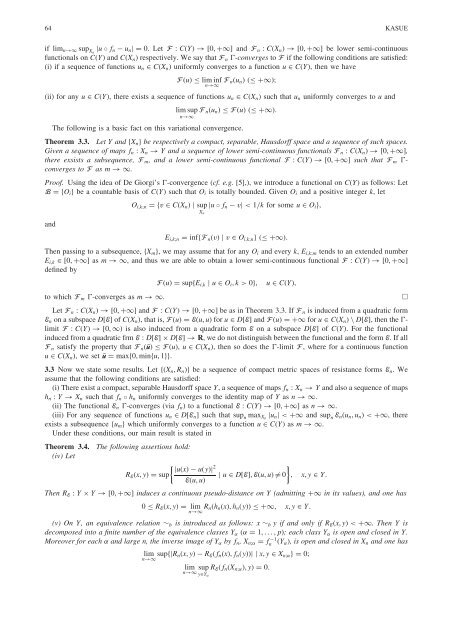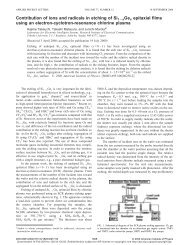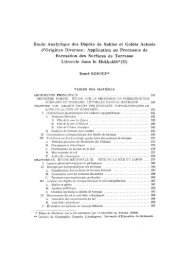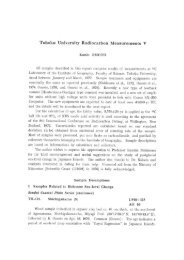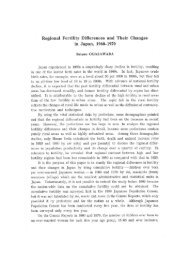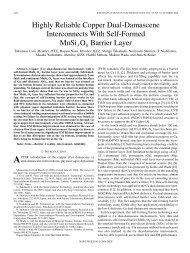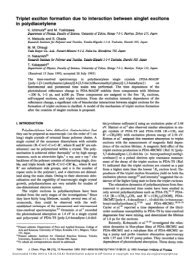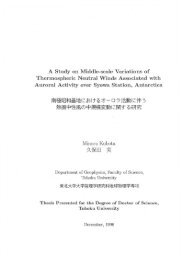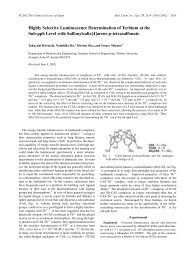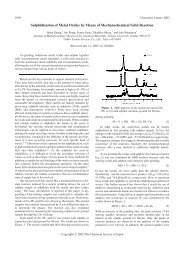Variational Convergence of Finite Networks
Variational Convergence of Finite Networks
Variational Convergence of Finite Networks
Create successful ePaper yourself
Turn your PDF publications into a flip-book with our unique Google optimized e-Paper software.
64 KASUE<br />
if limn!1 supXn ju fn unj ¼0. Let F : CðYÞ !½0; þ1Š and F n : CðXnÞ !½0; þ1Š be lower semi-continuous<br />
functionals on CðYÞ and CðXnÞ respectively. We say that F n -converges to F if the following conditions are satisfied:<br />
(i) if a sequence <strong>of</strong> functions un 2 CðXnÞ uniformly converges to a function u 2 CðYÞ, then we have<br />
F ðuÞ lim inf<br />
n!1 F nðunÞ ð þ1Þ;<br />
(ii) for any u 2 CðYÞ, there exists a sequence <strong>of</strong> functions un 2 CðXnÞ such that un uniformly converges to u and<br />
lim sup F nðunÞ<br />
n!1<br />
F ðuÞ ð þ1Þ:<br />
The following is a basic fact on this variational convergence.<br />
Theorem 3.3. Let Y and fXng be respectively a compact, separable, Hausdorff space and a sequence <strong>of</strong> such spaces.<br />
Given a sequence <strong>of</strong> maps fn : Xn ! Y and a sequence <strong>of</strong> lower semi-continuous functionals F n : CðXnÞ !½0; þ1Š,<br />
there exsists a subsequence, F m, and a lower semi-continuous functional F : CðYÞ !½0; þ1Š such that F m<br />
converges to F as m !1.<br />
-<br />
Pro<strong>of</strong>. Using the idea <strong>of</strong> De Giorgi’s -convergence (cf. e.g. [5],), we introduce a functional on CðYÞ as follows: Let<br />
B ¼fOig be a countable basis <strong>of</strong> CðYÞ such that Oi is totally bounded. Given Oi and a positive integer k, let<br />
Oi;k;n ¼fv 2 CðXnÞ jsup ju<br />
Xn<br />
fn vj < 1=k for some u 2 Oig;<br />
and<br />
Ei;k;n ¼ inffF nðvÞ jv 2 Oi;k;ng ð þ1Þ:<br />
Then passing to a subsequence, fXmg, we may assume that for any Oi and every k, Ei;k;m tends to an extended number<br />
Ei;k 2½0; þ1Š as m !1, and thus we are able to obtain a lower semi-continuous functional F : CðYÞ !½0; þ1Š<br />
defined by<br />
F ðuÞ ¼supfEi;k j u 2 Oi; k > 0g; u 2 CðYÞ;<br />
to which F m -converges as m !1.<br />
Let F n : CðXnÞ !½0; þ1Š and F : CðYÞ !½0; þ1Š be as in Theorem 3.3. If F n is induced from a quadratic form<br />
En on a subspace D½EŠ <strong>of</strong> CðXnÞ, that is, F ðuÞ ¼Eðu; uÞ for u 2 D½EŠ and F ðuÞ ¼þ1for u 2 CðXnÞnD½EŠ, then the -<br />
limit F : CðYÞ !½0; 1Þ is also induced from a quadratic form E on a subspace D½EŠ <strong>of</strong> CðYÞ. For the functional<br />
induced from a quadratic frm E : D½EŠ D½EŠ !R, we do not distinguish between the functional and the form E. If all<br />
F n satisfy the property that F nðuÞ F ðuÞ, u 2 CðXnÞ, then so does the -limit F , where for a continuous function<br />
u 2 CðXnÞ, we set u ¼ maxf0; minfu; 1gg.<br />
3.3 Now we state some results. Let fðXn; RnÞg be a sequence <strong>of</strong> compact metric spaces <strong>of</strong> resistance forms En. We<br />
assume that the following conditions are satisfied:<br />
(i) There exist a compact, separable Hausdorff space Y, a sequence <strong>of</strong> maps fn : Xn ! Y and also a sequence <strong>of</strong> maps<br />
hn : Y ! Xn such that fn hn uniformly converges to the identity map <strong>of</strong> Y as n !1.<br />
(ii) The functional En -converges (via fn) to a functional E : CðYÞ !½0; þ1Š as n !1.<br />
(iii) For any sequence <strong>of</strong> functions un 2 D½EnŠ such that supn maxXn junj < þ1 and supn Enðun; unÞ < þ1, there<br />
exists a subsequence fumg which uniformly converges to a function u 2 CðYÞ as m !1.<br />
Under these conditions, our main result is stated in<br />
Theorem 3.4.<br />
(iv) Let<br />
The following assertions hold:<br />
juðxÞ uðyÞj2<br />
REðx; yÞ ¼sup j u 2 D½EŠ; Eðu; uÞ 6¼ 0 ;<br />
Eðu; uÞ<br />
x; y 2 Y:<br />
Then RE : Y Y !½0; þ1Š induces a continuous pseudo-distance on Y (admitting þ1 in its values), and one has<br />
0 REðx; yÞ ¼ lim<br />
n!1 RnðhnðxÞ; hnðyÞÞ þ1; x; y 2 Y:<br />
(v) On Y, an equivalence relation b is introduced as follows: x b y if and only if REðx; yÞ < þ1. Then Y is<br />
decomposed into a finite number <strong>of</strong> the equivalence classes Y ð ¼ 1; ...; pÞ; each class Y is open and closed in Y.<br />
Moreover for each and large n, the inverse image <strong>of</strong> Y by fn, Xn; ¼ f 1<br />
n ðY Þ, is open and closed in Xn and one has<br />
lim<br />
n!1 supfjRnðx; yÞ REð fnðxÞ; fnðyÞÞj j x; y 2 Xn; g¼0;<br />
lim REð fnðXn; Þ; yÞ ¼0:<br />
n!1 sup<br />
y2Y


